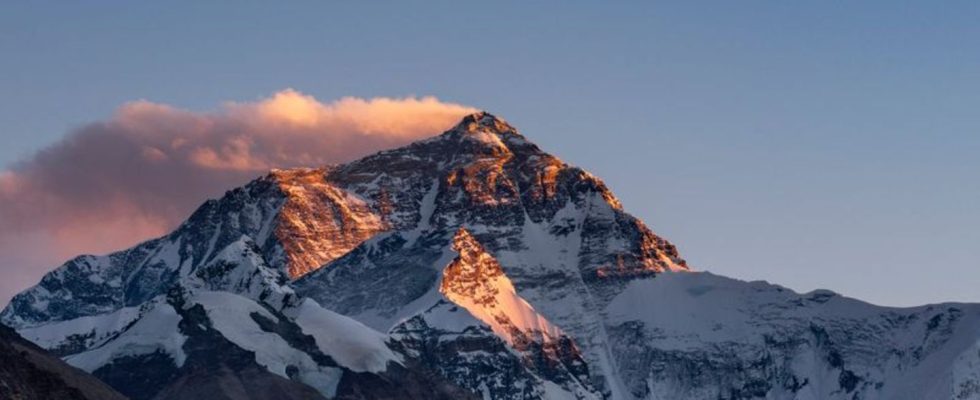In 1953, mountaineers stood on the roof of the world for the first time. A lot has changed in the mountaineering business since then. The ascent became easier – but also more expensive. He remains dangerous anyway.
He is a magnet for climbers. But many have lost their lives trying to reach the highest mountain in the world. The well-known Nepalese mountain guide Kami Rita from the Sherpa people has climbed Mount Everest 28 times. Nobody has done that before. When the 53-year-old climbed the 8,848.8 meter high mountain for the first time in 1994, it took him and his team just under a month to even reach the base camp. It’s much faster today. On Monday (May 29) 70 years ago, people stood on the summit for the first time.
Tenzing Norgay and Edmund Hillary made history back then – on May 29, 1953, late in the morning at 11:30 a.m. The two mountaineers reached the roof of the world, which many had previously considered invincible. Another milestone was set by Reinhold Messner and Peter Habeler, who conquered the summit without artificial oxygen on May 8, 1978. The mountain has not lost its fascination to this day. But for many it remains a dream.
Commercialization of mountain tours
In the three decades since Norgay and Hillary’s success, only 158 climbers, including 30 local guides and porters, scaled Everest, according to the Himalayan Database expedition archive. With the commercialization of mountaineering, this number exploded. According to the database, there have now been more than 11,000 successful ascents, including more than 5,700 by local mountain guides and porters. Among them are people who have reached the summit several times.
For mountain guide Kami Rita, today’s tours cannot be compared to those of yesteryear. “You can land directly with the helicopter at the base camp and order almost any dish there that you can get in a five-star hotel in the capital Kathmandu,” he told the German Press Agency. “If you have money, you can get almost everything else at the base camp – comfortable accommodation, internet connection and medical care.”
Today there are dozens of daily flights from Kathmandu to Lukla in the Everest region – and from there helicopter flights directly to the base camp, which is the starting point at an altitude of more than 5000 meters. There are also many hotels and tea houses where you can get used to the thin air at high altitude. An expedition now takes only half as long as it did back then, i.e. about 45 days.
With the commercialization of extreme sports, climbing Mount Everest has become easier – but also more expensive. The mountain has become more accessible, especially for rich people who can afford to pay thousands of euros for this dream.
Traffic jams in the dead zone
In recent years, the demand has even repeatedly led to traffic jams in the so-called death zone near the summit. The mountain on the border between Nepal and China can be climbed from either country. This year alone, the Nepalese Ministry of Tourism has issued permits to 478 climbers.
Khim Lal Gautam, a ministry official, says, “Mountaineering has become more accessible to the masses as expedition operators can organize safer and better planned expeditions.” In his opinion, the number of climbers should continue to increase.
Repeated fatal accidents
However, fatal accidents happen again and again. According to the Himalayan Database, a total of 299 climbers have died since 1953, including 113 local guides and porters on the mountain. A number of people may have died before then. For example, British mountaineer George Mallory disappeared in 1924. His body was not found until 1999, according to media reports.
But many are not deterred by such news. Mountain guides and suppliers say that foreign climbers are interested in Everest because of its name. It also attracts tourists because of its fame. Quite a few are driven to set a record – for example to be the first person of the respective country, gender or ethnic group.
At least 40,000 euros for an ascent
Increased interest has driven up costs. A foreign mountaineer pays at least 40,000 euros for an ascent, according to US mountaineer and blogger Alan Arnette. This includes the fee for a permit from the Nepalese Ministry of Tourism, which costs 11,000 dollars in the spring season, i.e. around 10,000 euros. Appropriate approval in China is even more expensive. This includes equipment, oxygen tanks, domestic flights, accommodation, food and a local support team to guide the route, carry luggage and cook.
Professional providers now have VIP services in their catalogue. That can cost up to 100,000 euros. This includes private chefs, deluxe accommodation, a helicopter on stand-by, a large team of helpers who carry up to 200 kilos of luggage and a photographer. Given the demand, there is sometimes even a shortage of local mountain guides and porters, says Kami Rita.
The younger generation in the mountains in particular is less interested in risking their lives on the summit. A local mountain guide can now earn at least 500,000 rupees (3,500 euros) per season, as several mountain guides from the Sherpa people estimate – more than twice as much as an average Nepalese earns in a year. The many foreign climbers brought money to poor Nepal.

